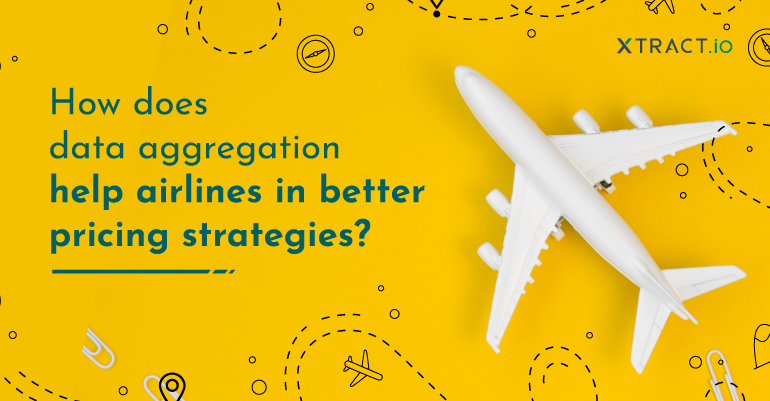In recent years, the way we live and travel has changed drastically. From how we commute to how we plan our vacations, there has been a lot of change. Hence, the aviation industry had to adapt to the way we live. Airlines must maintain a tight grip on their pricing to stay afloat and offer better services. This can help them create an effective pricing strategy.
Here’s how Xtract.io, with its data aggregation solution, helps airlines fix an effective pricing plan.
Data aggregation: In the aviation sector
Data aggregation is a process by which airlines gather and compile large data sets from various sources. By aggregating data from different sources, including passenger and cargo records, flight schedules, social media reviews, customer surveys, and reservation systems, the airlines can better understand the market and their customers. This can include everything from understanding the factors affecting customer behavior to determining the optimal airfare for the passengers. Through this, airlines can make informed decisions about price adjustments.
For example, when airlines plan their fare, they collect various data that can impact the final price of the passengers’ tickets. This includes the previous airfares, available inventory, passenger demands in the past, and competitor prices for flight tickets. Once they aggregate data into a single system, the airlines can create tickets with the most accurate price point for each trip. In addition, it allows them to maintain or increase customer satisfaction while maximizing profit margins.
4 ways the aviation sector can leverage data aggregation
By analyzing different airline routes, airports, schedules, etc., airlines can also identify areas that have seen an uptick in demand, such as popular holiday destinations, and adjust prices accordingly. This allows them to ensure they’re offering customers the best possible value while still making profits. Here’s how our data aggregation platform can help you:
Trend Analysis
Xtract.io helps you to monitor the airfare, route combinations, prices of various commodities, and popular trends. Further, this trend analysis helps them identify how these factors impact travel patterns. Airlines can adjust their pricing accordingly by knowing what is popular and how demand for certain items has changed over time. Trend analysis allows airlines to plan for the future and proactively respond early to avoid long-term financial damages.
For example, the Christmas holidays are peak travel times, and airlines raise their ticket fares every year during this season to profit from the increasing demand. Alternatively, if there has been a drop in air traffic recently due to economic conditions or other unknown factors, airlines slash down the airfare on selected routes in order to not lose customers.
Behavior analysis
Customer behavior analysis is a valuable tool that airlines use to monitor prices and tune strategies accordingly. By recognizing their passengers’ interests and wants, airlines can identify when demand for certain flights or destinations is low and adjust the pricing accordingly. Additionally, by analyzing customer behavior, airlines can determine which booking classes are in high demand or which routes passengers frequently take and set their prices accordingly.
Understanding customer behavior is crucial in airline marketing strategies like booking class upgrades and flight deals. The airlines know which classes of the flight are being booked most often, and they may place more lucrative offers on them to entice the customers away from cheaper options.
Historical analysis
Historical analysis is another important service that our data aggregation solution offers. It can help airlines in several ways, including price monitoring and forecasting. By understanding past pricing patterns and their performance, airlines can compare current airport prices with past values and assess the fluctuations over time. Further, the airlines can predict future trends and determine when to raise or lower prices for their products and services. This allows them to protect their market share and improve profits.
Historical data also helps airlines identify potential market failures and possible pricing strategies that could minimize losses or increase profits. For example, based on a survey of the bookings in different classes such as economic, business class, airlines fill their minimum capacity at the lowest fares and increase fares later for the most-booked class.
Competitor Analysis
Targeting your passengers with the best deals at specific times is the best way for your airlines to stay ahead of the competition. Our data aggregation platform helps you to perform effective competitor analysis, detect and monitor competitor behavior and set striking price strategies.
Competitor analysis provides insights into how other airlines are pricing their services and may provide valuable clues about where your company can improve. In addition, this information can help in detecting potential price cuts or increases that may be launched in the future. It can also reveal patterns indicating when sales will likely rise or decline.
For example, imagine your competitor is increasing their prices on certain routes, then you may decide to delay or cancel new investments in those segments to maintain market share. Alternatively, if one of your rivals begins launching new low-cost flights, your airline might reduce costs to stay ahead of the curve.
Summary
Airlines are always on the lookout for ways to improve their revenue and profitability. However, monitoring the changes in the market can be costly and time-consuming. That’s where Xtract.io comes in! Our data aggregation platform helps airlines monitor their pricing strategies in real-time and make adjustments as needed. Read to find out how we helped a prominent aviation firm overcome flight disruptions with our simple data aggregation solution.
Don’t wait for a wake-up call to set your pricing strategies right. Request a free trial to know how the Xtract.io data aggregation platform can help your airlines make rational pricing decisions!







